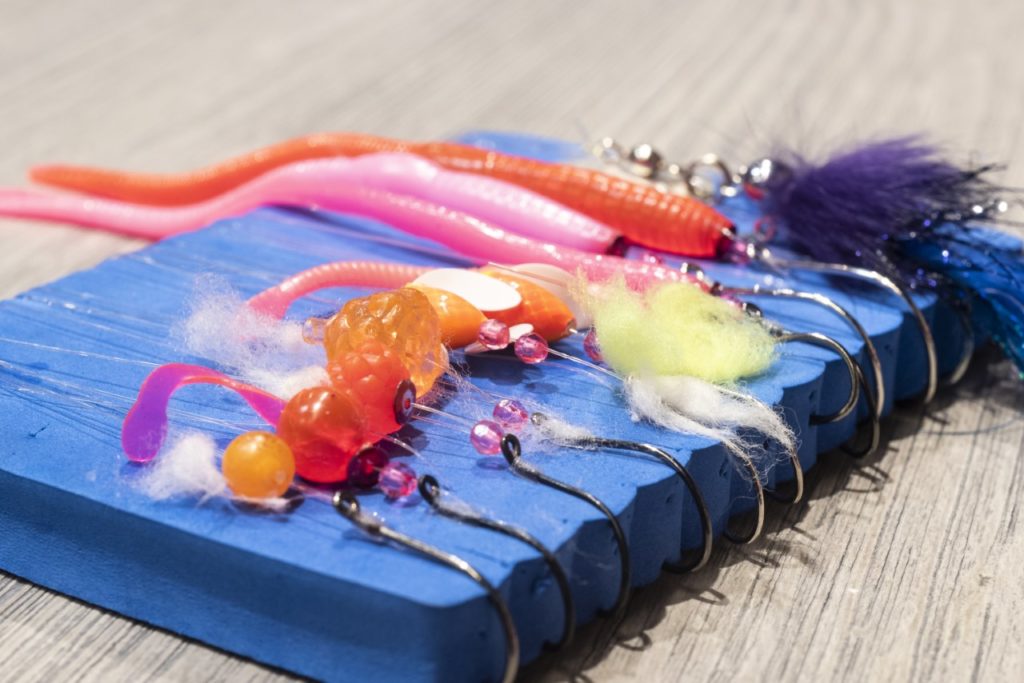OUTLOOK
We have a beautiful forecast coming into the weekend. When we say beautiful, it is not all sunshine and lollipops. We will be seeing some rain but for a winter fisherman it looks perfect. They are forecasting a bit of rain Thursday (as we are writing the report) with more to come on Friday and Saturday then a shift to relatively nice weather on Sunday/Monday. The other one you want to pay attention to is the temperature. She is going to be warm! At least for the time of year. This warm rain will rise river levels, get fish moving and feeding. We expect good fishing over the weekend on all our major river systems so if you can make it out this weekend it should be worth it!
Below we have details on the Squamish, Matt was out freezing his butt off last week and he is out again today and he has details on the Squamish egg fishing below.
Interior ice fishing has also started, and we are stocked up on your ice fishing essentials. Aidan had a little overview that you will want to look at if you plan to get to the interior over the holidays. It’s a fun and easy way to spend a day.
On the steelhead front it is time to get out scouting and prepare your gear. This week Alex has a great review of what’s on his leader board to cover a range of steelhead conditions. If you are new to steelhead drift fishing, you will not want to miss it and even if you are veteran you might find some inspiration. Check it out in the Vedder River section of the report.
Sterling has an excellent writeup on how to bead fish with a gear rod as well if you want to bring this technique when out scouting for steelhead. Not only is it very effective for steelhead but it also is a great method for other species in the river right now and hooking a few bulltrout can make the steelhead scout way more entertaining.
On the fly tying front, we have two pieces for you guys who want to hit the bench. Jordan had a detailed look at some of our favorite warmwater patterns. If you are planning a trip to CXI or any warm water destination, he features 5 of his favorites.
If you are not warmwater bound we have another video this week. We released a fly tying video on a great easy steelhead pattern that you might have seen Matt tying at the steelhead jam session. Check it out here if you want to add to your steelhead box.
Jason has a saltwater update and it continues to be good. See his saltwater section at the end of the report.
Lastly – Matt will go over the major fisheries and some conservation issue updates so as always if you want to keep up to date on fisheries politics, current events and all our fishing opportunities check out the video version of the report here!
CLASSES AND COURSES
Our 2020 course listing will be released next week so keep an eye on your inbox for the full year’s course lineup and remember courses make a great Christmas Gift!
FRESHWATER FISHING REPORTS
Chilliwack/Vedder River Fishing Report – Leader Board Prep
The Vedder has been pretty quiet as of late. There are only a few stragglers from the tail end of salmon season and the first few early steelhead of this Winter have been pretty elusive. This is a great time to hit the river though and scout out some potential water for the upcoming steelhead season, and it is also a great time to get ahead of the game and prepare all your arsenal for when the time comes to hit the river hard.
One of the best ways to get ready for steelheading is to tie leaderboards. Leaderboards are simple, yet ingenious, inventions that allow us to pre-tie a handful of leaders with different presentations the night before a big fishing trip and to have them all ready to rig up. This means much less fussing around with tying knots while on the river and the option to quickly change up your bait/lure if the situation calls for it. This increases our efficiency exponentially and the more time you spend casting, the more chance you will have of hooking a fish.
How does one rig up a leaderboard? There is no wrong or right answer; the key is doing it in some manner that makes it easier for yourself when you are fishing, so come up with a system that works for you. Small things like maintaining all the leaders neat and orderly fashion, tying them extra long (2-3 feet will suffice), or tying swivels or snaps onto the connecting end can help keep things running smoothly. The less you have to think about it the faster and, again, more efficient you will be when changing your leader.
What do I put on my leaderboard? There are a million things you can pre-tie on your leaderboard! Pretty much anything that a steelheader regularly uses is fair game and every steelheader’s board will be different. In saying that there some staple presentations you should have rigged and ready to go. I will outline a few of these below and explain why you will want to have them.
1. Bait Rigs – Don’t be that person that puts bait on their leaderboard; that is not what I mean by bait rigs! These ones are your pre-ties that you will have ready for adding bait to such as roe and shrimp. This can mean just a bare hook tied on a leader, some wool on a hook, or a spin n’ glow threaded above a bare hook for added vibration. These are highly versatile leaders and I recommend having a bunch of these tied up if you are fishing a system that allows bait. Not that you will be changing out these leaders to switch presentations much, but they are ready to go if you break off, knick up your leader, or dull your hook on a rock. Hook sizes will vary from #6 up to #3/0 but that will depend on the water conditions you will be fishing in.
2. Single Eggs/Gooey Bobs – A classic and a great alternative to bait, a single egg or a gooey bob suspended or pegged above the hook is a must have for every leaderboard. These egg imitations can be soft plastics like Mad River Eggs, Jensen Eggs, Cleardrift Clusters, or Delta Gooey Bobs, or they can be hard beads like the Blood Dot Eggs from Trout Beads. You will want to peg most of these with either bobber stops or silicone pegs (Trout Beads makes a great product). These leaders can be fished in faster water where bait may blow off the hook and you can size them accordingly, from an 8mm natural coloured bead in low clear conditions up to a fluorescent orange magnum Gooey Bob for fast and dirty water. I like to add a little bit of white wool to these to give it more action and to hold additional scent, but it is not necessary. Eggs are important to tie up when at home as it is a pain trying to rig these up on the water when your hands are freezing.
3. Worms – Another classic is the rubber worm. With the bigger 4″ and 6″ worms you will basically have to pre-tie unless you like doing needle work on the river, so chalk this up to another win for having a leaderboard. This setup involves threading a plastic worm onto the leader with a needle. They can be rigged right side up, upside down, or even wacky rigged. When rigging, typically the line will go in and one end and then come out the middle of the worm, a little past the halfway point. Pink is the traditional colour as it mimics a washed out worm floating through the current, but don’t be afraid to have a few different colours in your arsenal. I like to have at least one 4″ and one 6″ ready to go and then I have all my water conditions covered. In small systems or really clear water I will downsize to a 3″ as well. Mad River worms and Hawkeye worms are great, as are Powerbait Floating Trout Worms for a smaller 3″ option.
4. Blades – A great option for following bait chuckers, a blade is flashy and often can get stale fish wound up when nothing else will trigger a bite. I personally keep this pretty simple with either a straight nickel or straight brass size 3 or size 4 Colorado blade. However, it isn’t a bad idea to play around with colours and you can either buy 50/50 blades out of the package (Cleardrift offers a bunch!) or get some prism tape and add colour on your own! Another way you can shake this one up is to try different style of blades; for instance, try drifting a Gibbs Mini G or a Hildebrandt Little Shaver instead of a standard Colorado. On highly pressured rivers like the Vedder this difference in flash and flutter is new and exciting for these fish. I don’t go crazy pre-tying blades up but I make sure I have at least one.
5. Jigs – Jigs are another great follow up presentation and can be extremely versatile. They are flashy and have a lot of action, but on the flip side can be much more finesse than a big flashy blade. There are also a multitude of colour combinations you can put together. While bright colours are go-to’s like pinks, whites, and oranges, I like to have a dark jig to contrast everything else I have on my leaderboard. This means blacks, blues, and purples. It is easy to get carried away and pre-tie a whole bunch of jigs with different colours but to keep things clean and streamlined I leave the bright colours to the worms/blades and the darker presentations for the jigs.
That is my general take on a leaderboard for steelheading. There are lots of other things you can do and definitely lots of modifications to these tried but true presentations. With some tweaking and trial and error, you can build your own unique leaderboard that will crush fish no matter what the conditions are. Come down to the shop and we can get you started on building your own!
Alex Au-Yeung
Squamish River Fishing Report
I hit the river last weekend and there is no way to sugar coat it. She was freak’n cold and a challenge. Temperatures in the morning on the upper river were negative 7 on my car thermometer and she stayed at that temp most of the day. The lower river was much warmer but needless to say this made for tough fishing. We had iced guides and the dreaded slush-bergs (clumps of slush that form on the rivers surface).
We did catch a couple fish and missed a handful of bites. This beautiful rainbow was a nice heart warmer and it was certainly needed to help with our frozen hands. My hats off to the guys I was with for toughing it out.
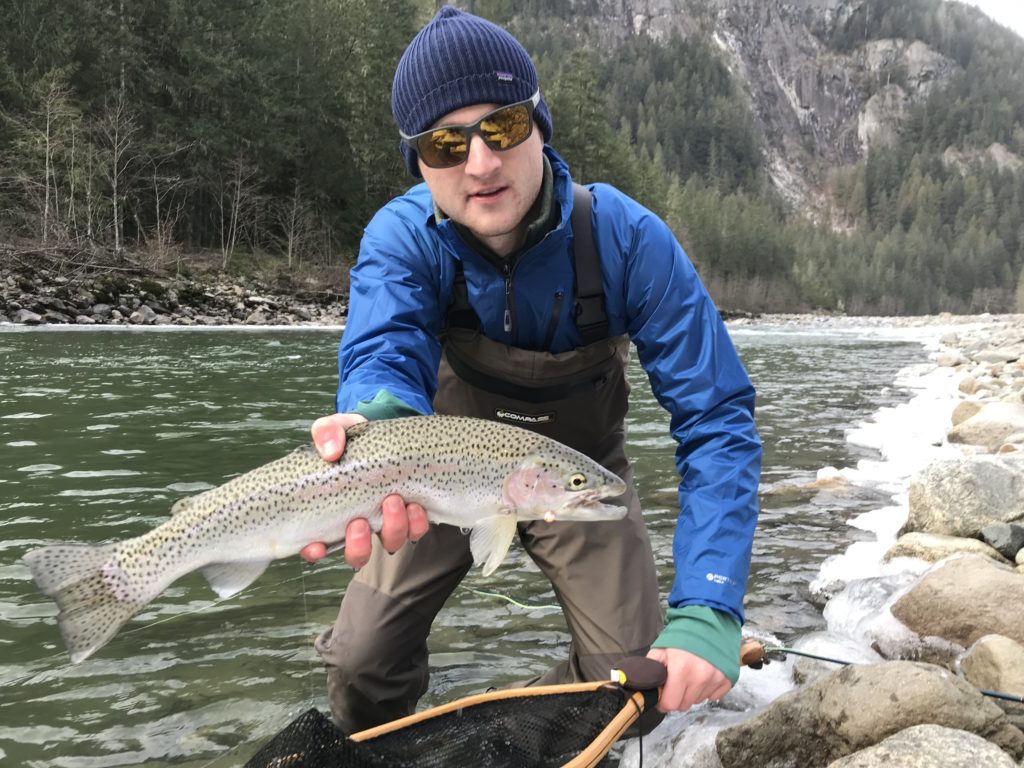
In these kinds of conditions, I won’t lie, you cannot expect good fishing. The fish’s metabolism shuts down, bites you do get will be very subtle and hard to detect and with these kinds of temps a few fish is a good day.
The good news is the weather has changed and we are getting weather that I consider perfect for egg fishing and streamer fishing on the Squamish. Temps will hit highs of 9 and with rain in the forecast to colour things up I expect good report from this weekend. If you are egging make sure you have a mix of colours. The rain may colour things up a little and, in these conditions, I like a colour that falls in the middle of the spectrum from super bright like the “cherry bomb” to the washed out white eggs we use when things get really clear.
Matt Sharp
EGG FISHING FEATURE
If someone asked me “What’s the one technique I should learn and be able to catch the most fish”, I would easily respond with beading eggs. It’s as simple as it comes, peg an appropriately coloured bead 2 inches up from a size #2-8 hook and fish it confidently and you’ll be amazed at the versatility of this simple set up. I have fished beads at every point of the year in our river systems and have reaped the results while hooking up on everything from small trout to steelhead to chinook. It’s also extremely versatile as it can be fished with both gear and fly setups. Beads are a great option in the upcoming months as the trout in our system have followed the spawning salmon and are getting plumped up on loose eggs that are dislodging from the spawning beds. The same egg setups, at least for gear fisherman, can also be used for the upcoming steelhead season. Saying all this, there are a few important aspects that I should point out when it comes to choosing an appropriate bead and gear.
You’ve probably noticed that there are a lot of beads to choose from on the market. They all vary in size (6-10mm), colour and material (rubber/plastic). The reason for this is to mimic the stage of an egg that you’re fishing, as well as what species you’re targeting. Transparent beads are meant to imitate the early stage of an egg. However, as the egg sits in the river, it takes on an opaque (mottled) to solid color. You should follow this trend as best as you can. At this point of the season, most of the salmon have spawned and the color of the egg should match that so I would fish more of a mottled or solid coloured pattern. For size, I feel like you can never go wrong with fishing a standard 8 mm bead. This can get a bit tricky depending on what salmonoid species were or are in the area you’re fishing. Chum is more of the 8-10mm size while pinks/coho are typically 6-8 mm so it’s good practice to ‘match the hatch’ if you’re being particular. I’ve never noticed a large difference between fishing a rubber or plastic egg, but have always leaned more to the plastic egg side of things simply because I love the way they look and sit in the water. I find that pegging them is a much easier option since the leader line can cut away at the rubber based eggs. Saying that, Cleardrift and Mad River have both come out with fantastic looking rubber eggs lately and I’ll be giving them a go this steelhead season. Here’s a picture of a few of my hand picked egg patterns that I use to target trout and steelhead.
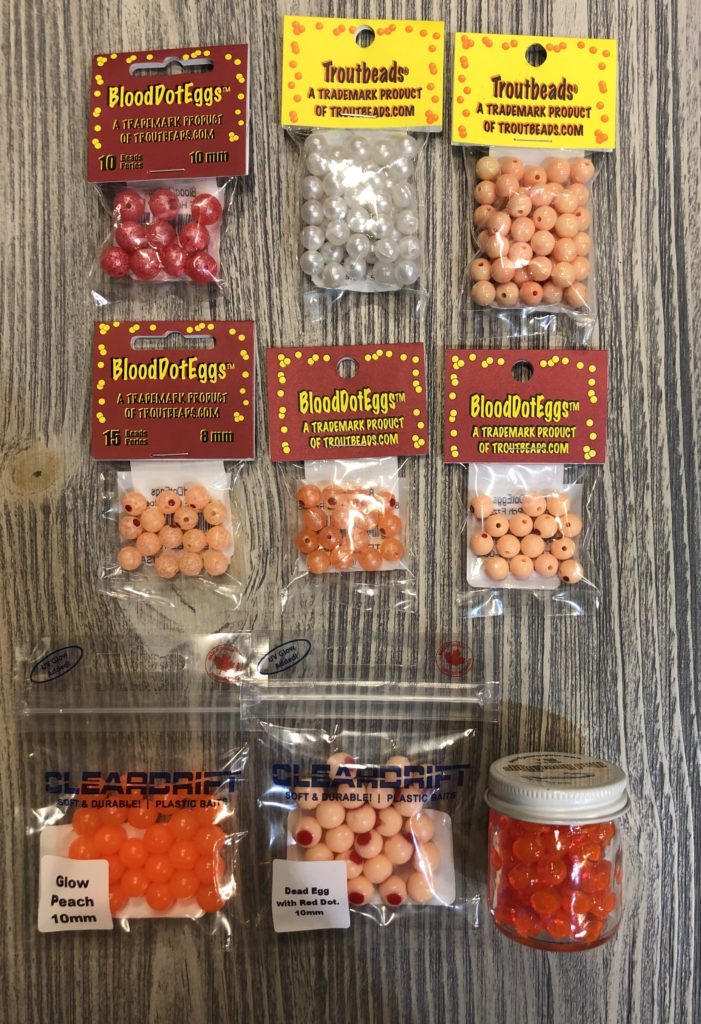
The set-up for this style of lure is also extremely simple for gear fisherman. I typically fish this in slower water through small to medium depth pools (4-7 ft) and tail outs to pick off trout and steelhead so neither a large float (11-20g) or much weight is needed. I typically use split shots to balance my float as it gives a very clean presentation and holds the bead at a steady level. For leaders, I make most of my leaders 18 inches using either 5-7 pound Seaguar fluorocarbon for trout or 12-15 pound for steelhead.
This was a very heavily gear focused article but the concept for fly fisherman is very similar and might be an article for a future day. As always, be sure to stop by the store if you have any questions about fly fishing setups too.
Sterling Balzer
WARMWATER FLY FEATURE
This week, I’m going to change things up and talk about one of my favourite fisheries: warmwater/tropical.
In other installments, I may cover topics such as gear, locations, preparation, and tactics; but in this one I will be covering five of my favourite flies. This will hopefully provide some inspiration at the bench and vise as you stay warm this winter. In no particular order:
Fly One: The Crazy Charlie
Since its creation in 1997 by legendary Bahaman guide ‘Crazy’ Charlie Smith, this fly has been a staple anywhere you may travel, regardless if it’s in the Bahamas. Simple by design, it can imitate small shrimp and crabs. I like to tie this pattern in a variety of weights, all the way from small bead chain to a medium sized double-pupil lead eye, which is considerably heavier.
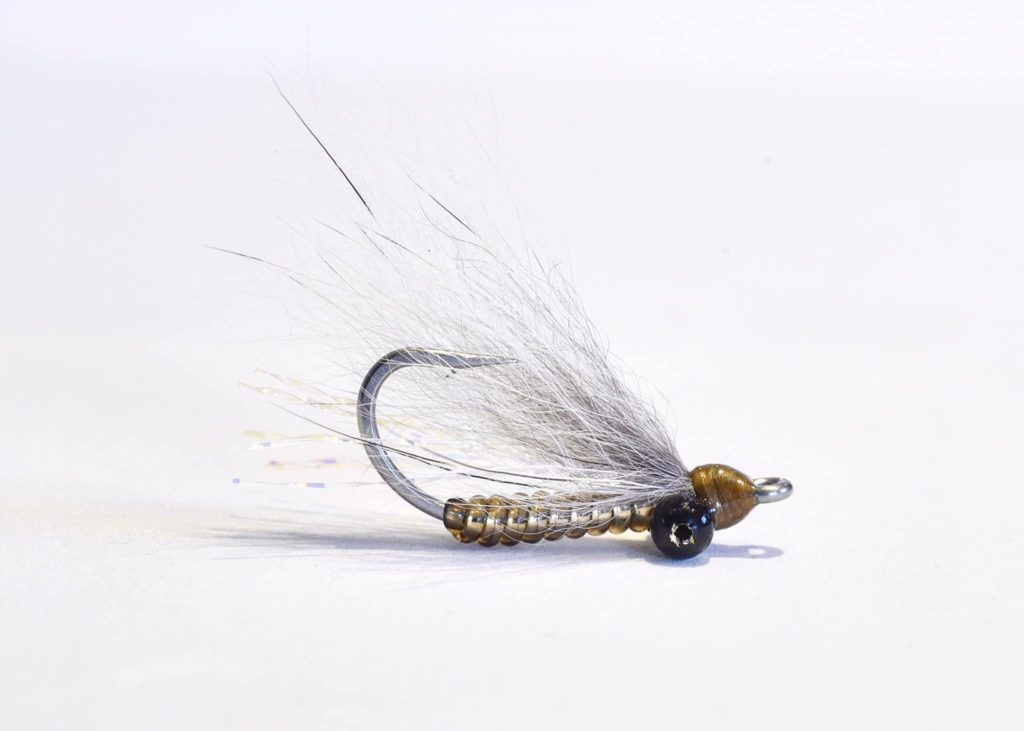
Fly Two: CXI Special
Even though ‘similar’ to a Crazy Charlie, the Christmas Island (CXI) Special is quite different. This fly probably deserves its own row in your box. There have been times where simply changing from a Crazy Charlie to a CXI special was the difference maker, even if they were the same colour and size. Just like the Crazy Charlie, a variety of sizes can be key.
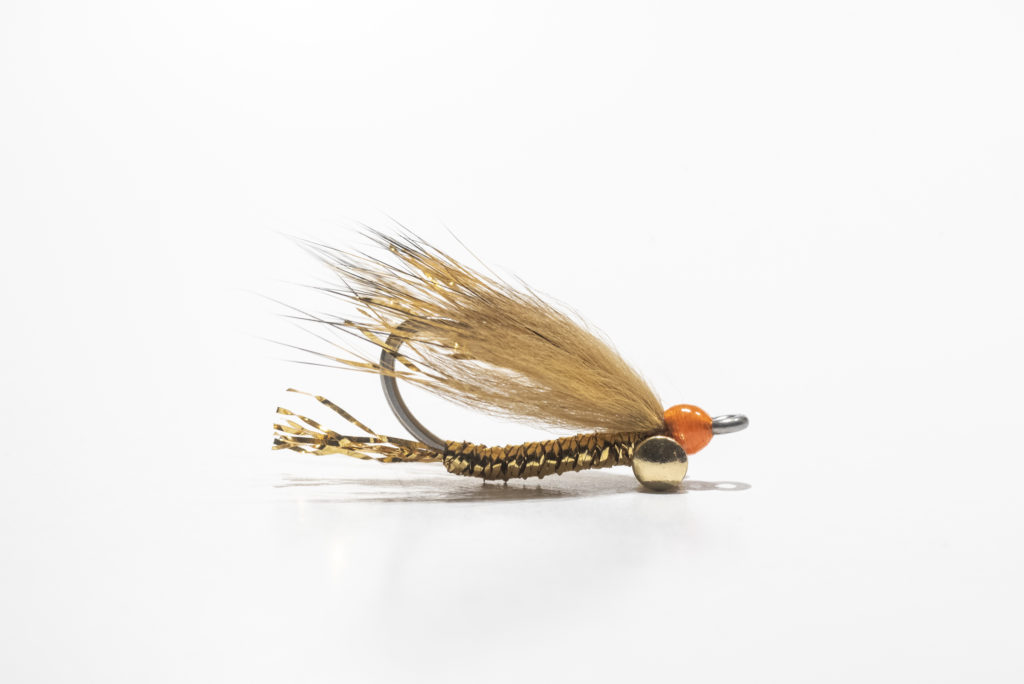
Fly Three: Spam and Eggs
A little more involved than the patterns mentioned above, this fly was created to fool even some of the pickiest fish: Hawaiian bonefish. Though this fly can be tied to size, it was originally tied larger than most people would expect: #4 and #2 Developed by one of the pioneering guides in Hawaii Coach Duff, this fly has been eaten by fish the world over.

Fly Four: Itchy and Scratchy
A more realistic fly than impressionistic pattern, this fly also has its roots in Hawaii. Made popular by Mike Hennessy, this fly is quite dull and plain, just like the Spam and Eggs. That said, once in the water, it comes to life and would probably even trick me. The key to both of the Hawaiian inspired patterns is the lack of flash, and how neutral and muted the colours are.
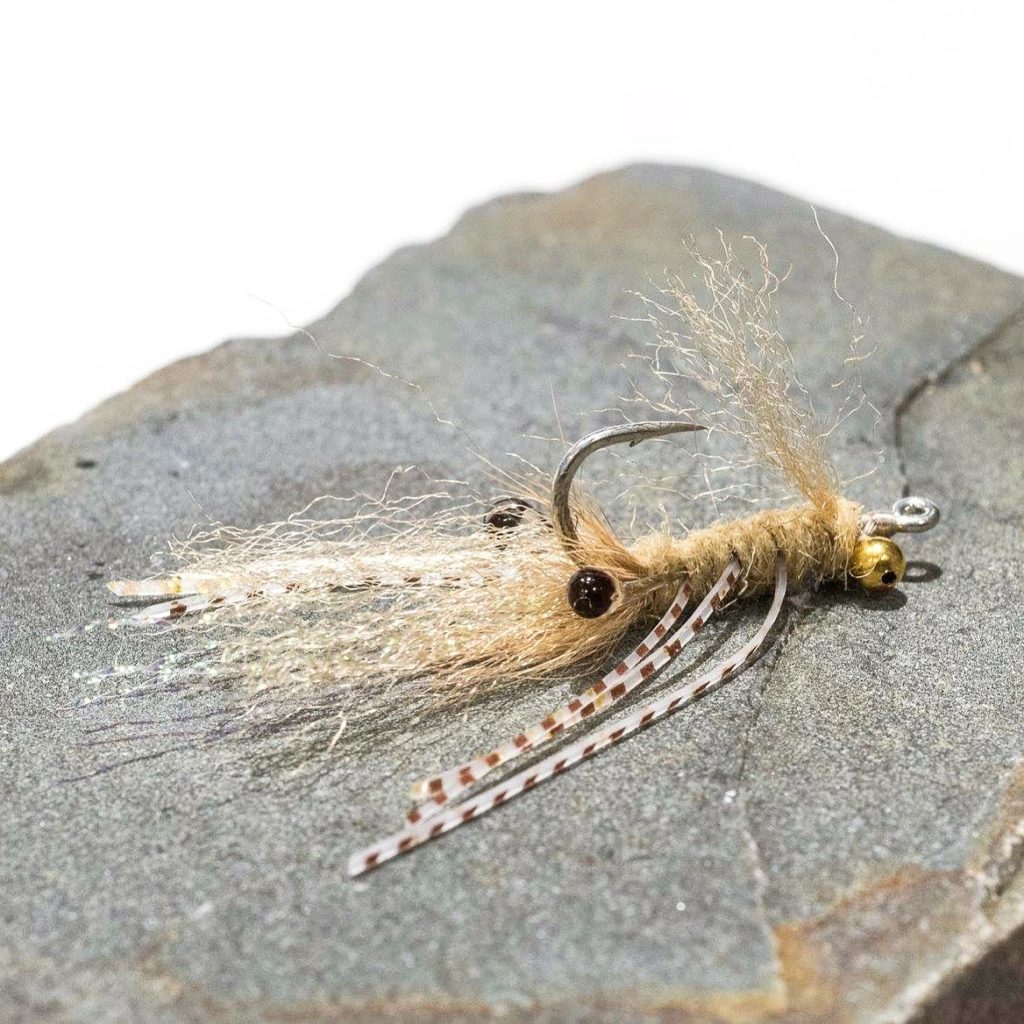
Fly Five: Small fold-over crab
These small crabs patterns are really simple, yet deadly effective on picky fish. Part of the reason I think it works so well is that it doesn’t look like a crab. Unlike other larger patterns, this fly is small, impressionistic, and generally lands pretty light. If you’re looking to trick spooky fish that focus on crabs, this fly is a must-have.
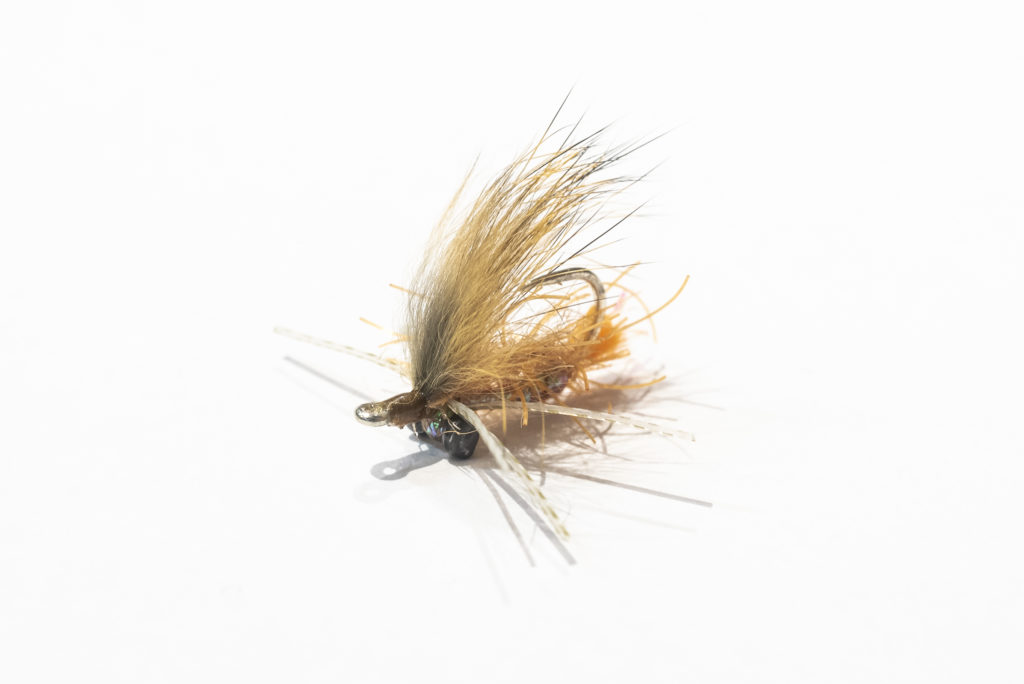
If you were to have these five patterns tied in various colours and weights, ranging from #10 to #6, including a couple #4’s, you would probably be safe to travel the world chasing bonefish. That being said, you can use these flies for Trigger Fish and Permit as well, making these quite versatile.
Happy tying!
Jordan Simpson
ICE FISHING FEATURE
Winter is here, which means the end of many fisheries, but also the start of a niche fishery that many Vancouverites overlook but if done right is super fun. Ice fishing is often seen as boring by many, but as with any type of fishing, it’s only boring if you’re not catching anything.
When looking for a rod, always flex them prior to committing. They should have a soft, flexible tip, and should bend all the way through the blank. When it comes to line, it can make all the difference. Always get “ice” style mono or braid when loading up your reel, as standard monofilament becomes very brittle in the cold water, and is also stiff as a board making jigging less natural. Next is picking a location on your favourite lake. I am most comfortable fishing in 25 – 35 ft of water for trout, generally on the shelf of a drop off. Often, it’s tough to know where to punch through the ice, so I suggest looking at the depth charts of your specific lake at gofishbc.com (may favourite lake fishing resource.) Lastly is your lure, there’s no hard and fast rules on what lure is best, personally I like small trout spoons such as Gibb’s Mini G or Hildebrandt’s Little Shaver. The biggest thing to look for is a nice smooth flutter on the drop. The other most common way to target the hungry trout is with bait. Shrimp, Krill, and Dew worms are my go-to’s.
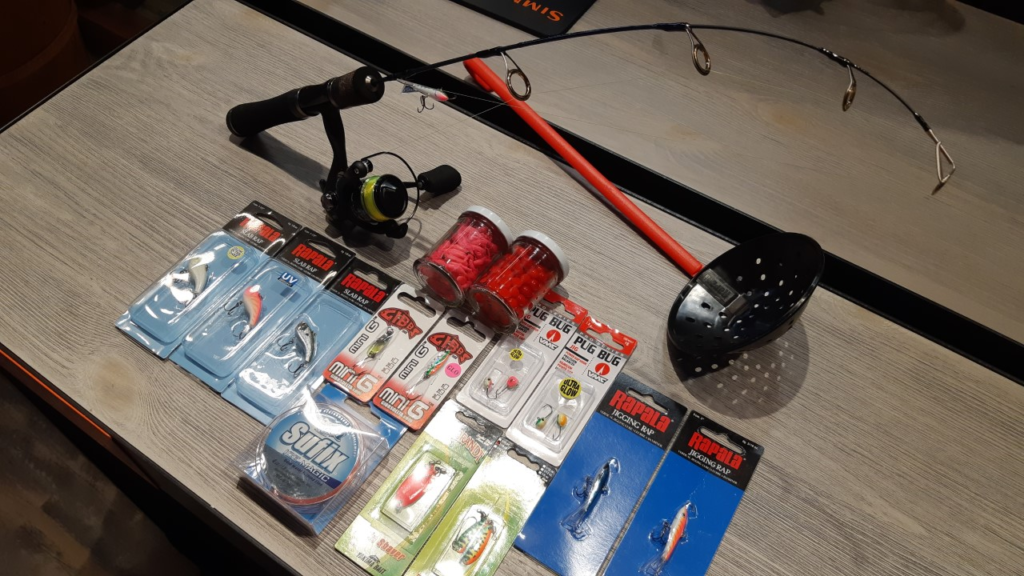
Always check ice levels before walking out on a lake, ice thickness should be at least 4 inches of clear ice to be certain that it will hold your body weight. If the ice is cloudy the whole way through, it is weakened due to air trapped inside of it, and should be avoided.
Stay frosty,
Aidan Munro
SALTWATER FISHING REPORTS
The fishing was pretty good this past week so nothing to complain about there. The weather has been a bit trickier though, and again it looks like we are in for a mix of sun, rain, and different winds in the days ahead. If you can pick a day where the wind wants to cooperate its definitely worth getting out there.
As usual, the fish have been close to the bottom as that is where the bait is hiding. The fish have had a mix of herring and anchovies in their stomachs so the 3.0 and 3.5 size spoons have been working well. Hootchies have also been working well and this should be no surprise as the slender profile is very similar to that of an anchovy. Gibbs Skinny G is also an excellent choice when the fish are on anchovies. Always remember to check out the stomach contents of your fish and adjust your presentation as needed.
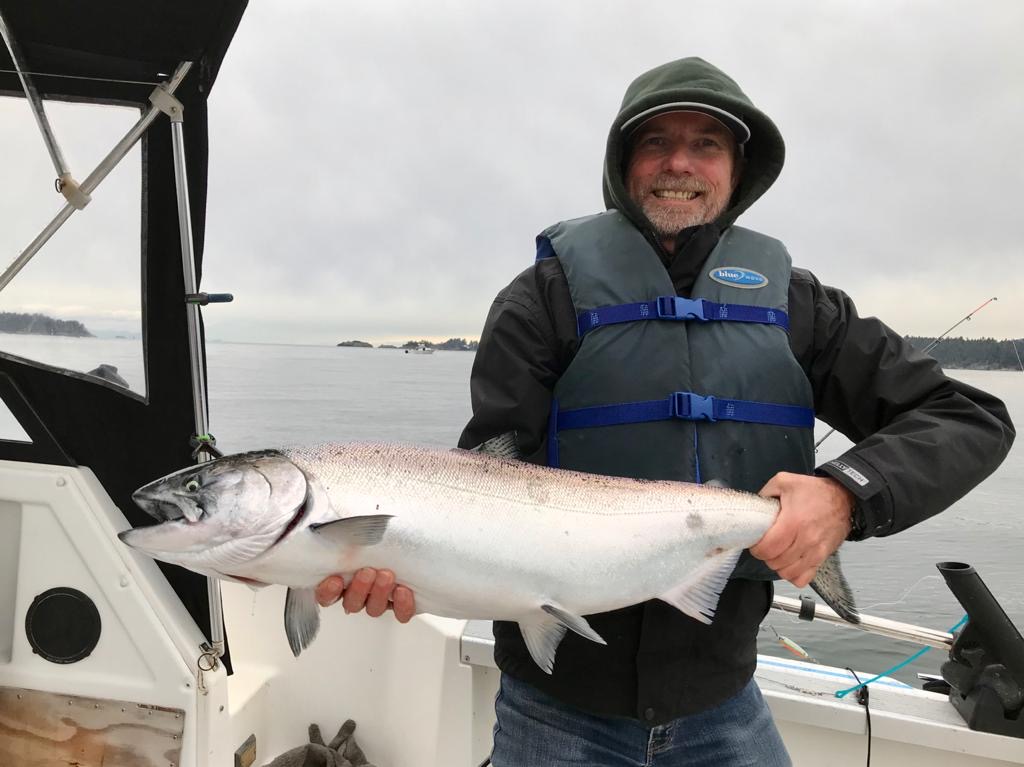
Prawning has been consistent and crabbing has been so so, with a few pockets of keeper size crab here and there. If you have some time off this December, give us a call and book a winter chinook fishing trip. It’s a great way to spend a winter day and the chinook and prawns are always popular on the dinner table.
See you in the shop or on the water,
Jason Tonelli



